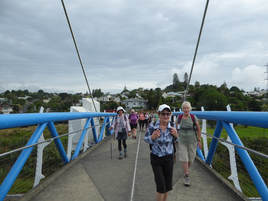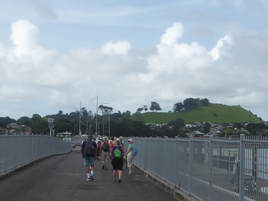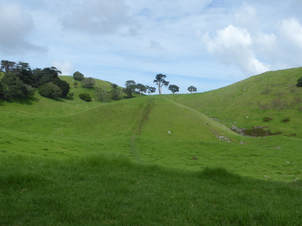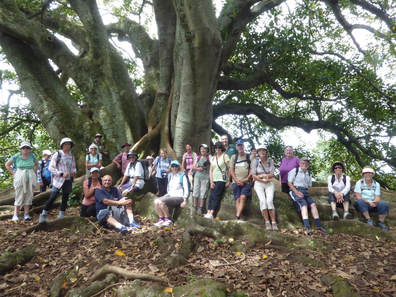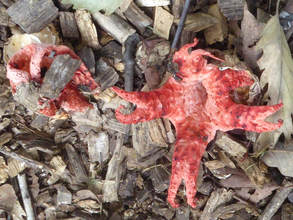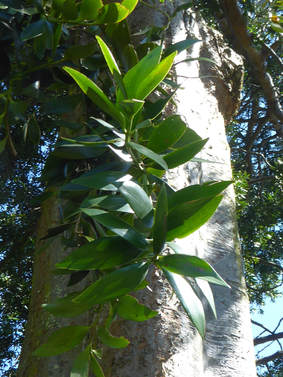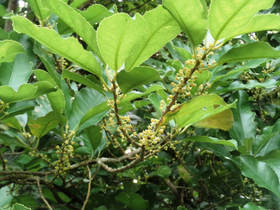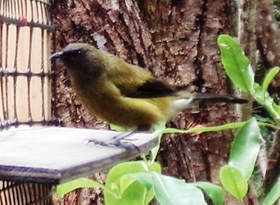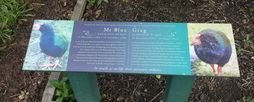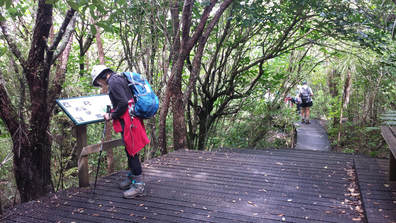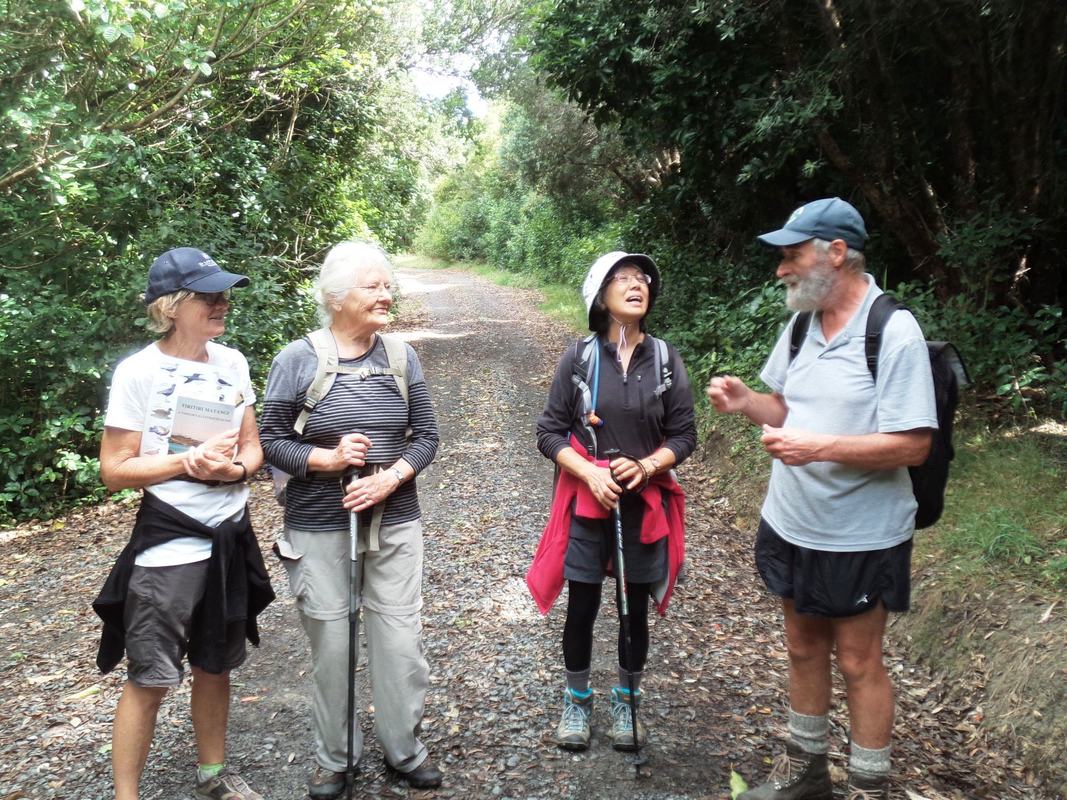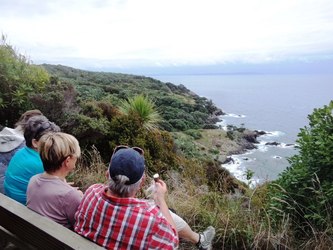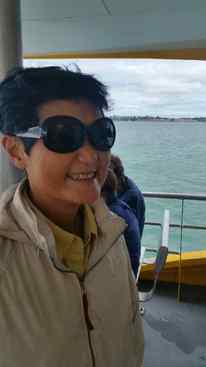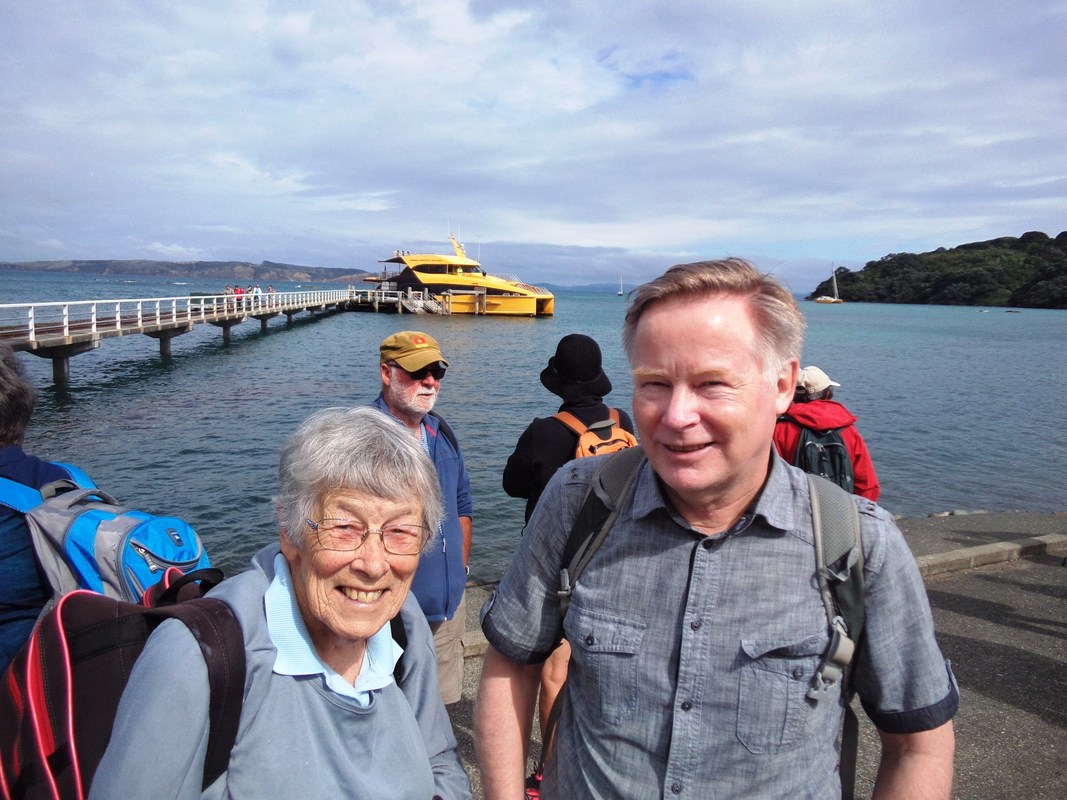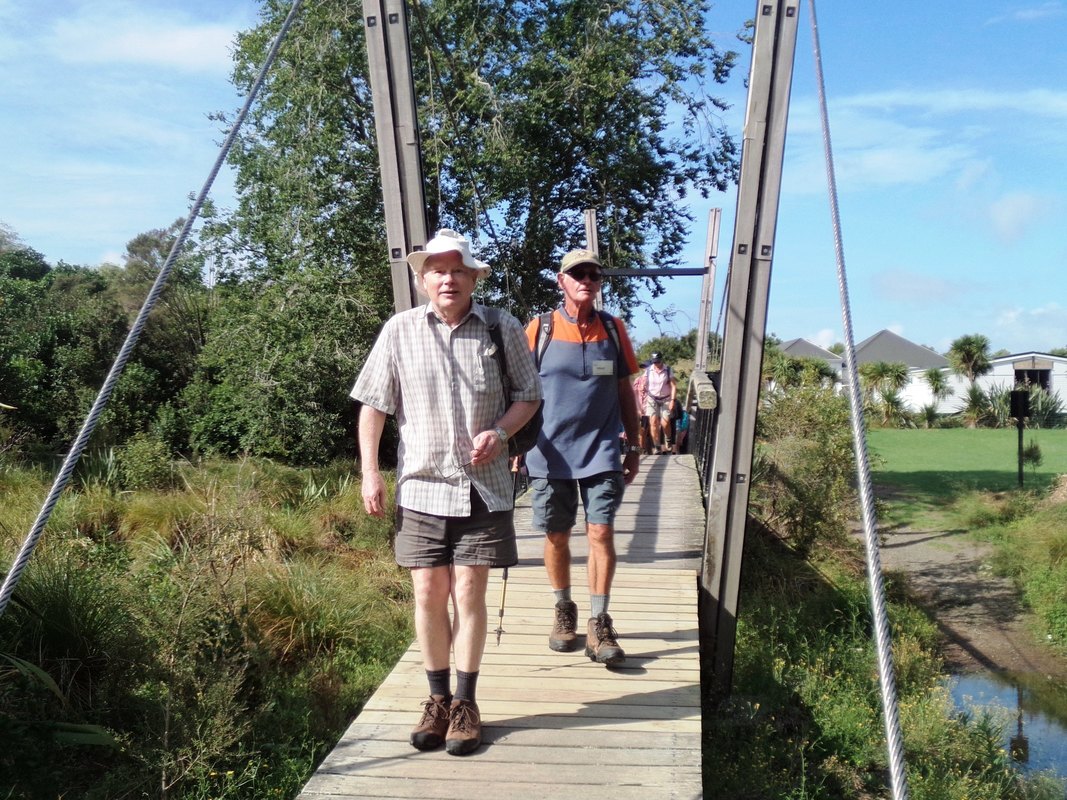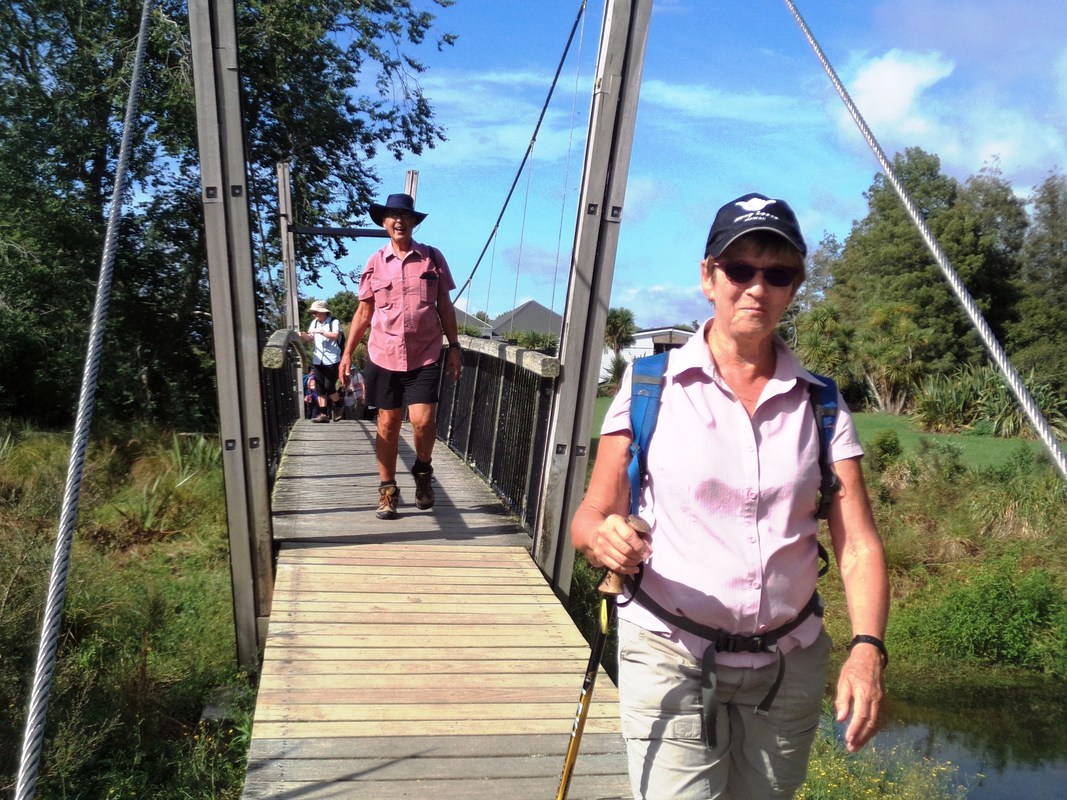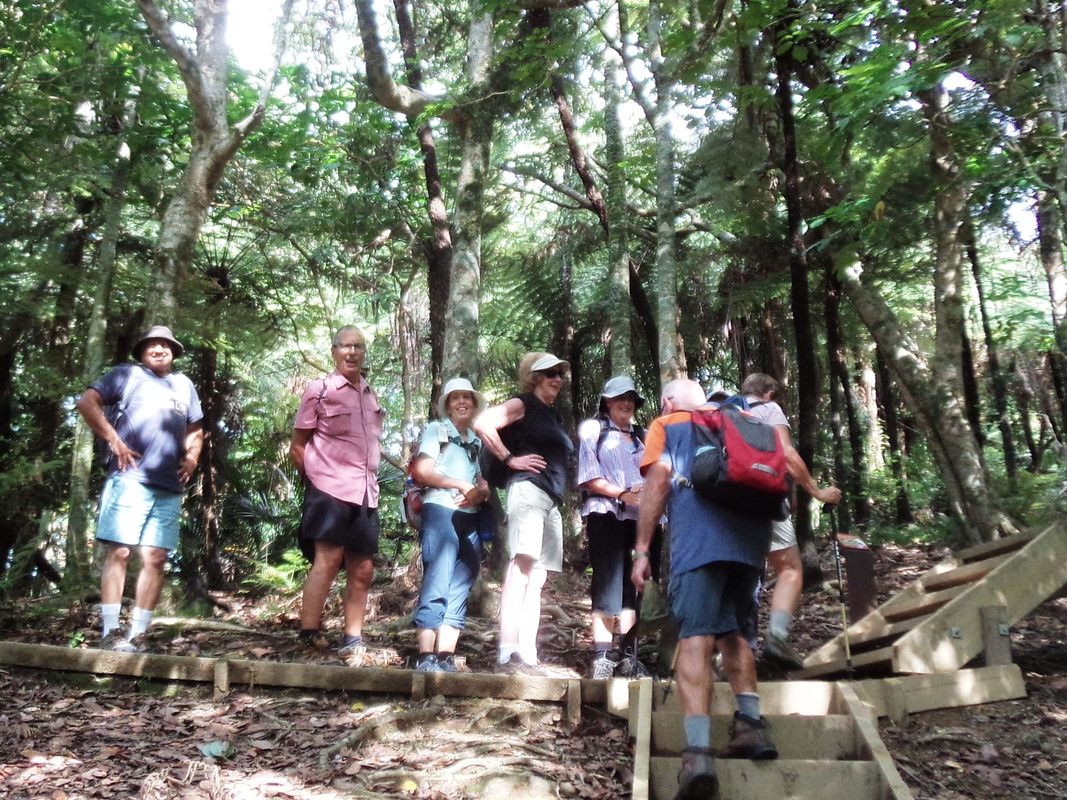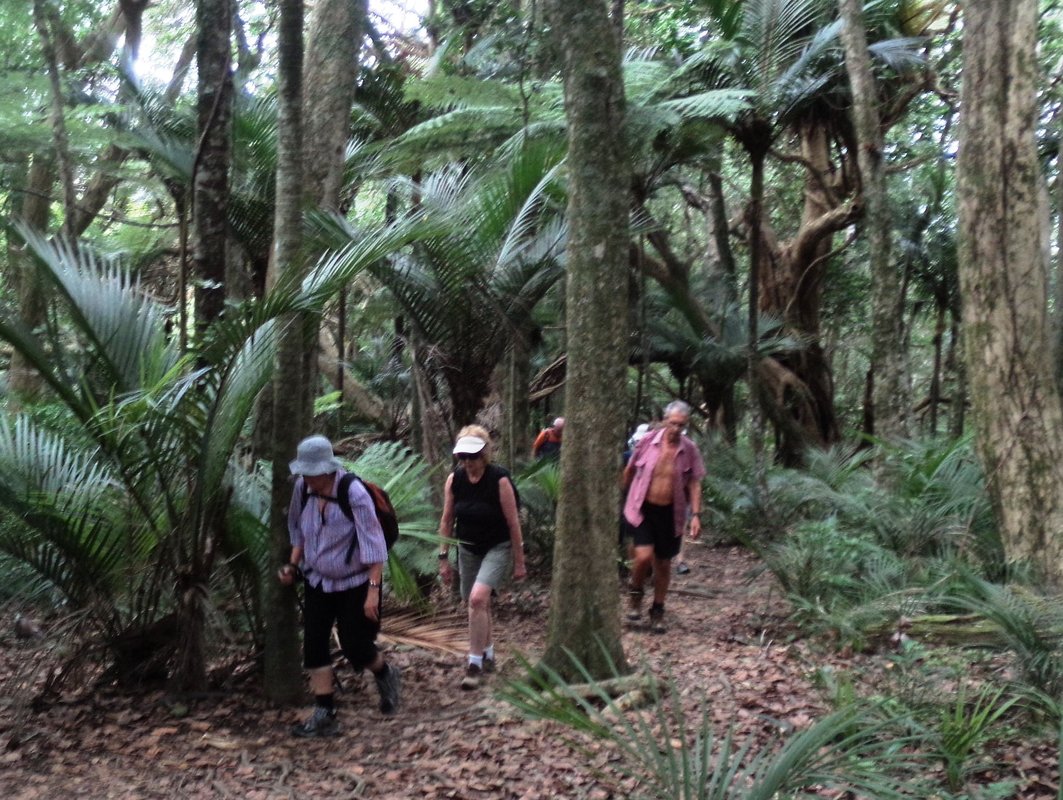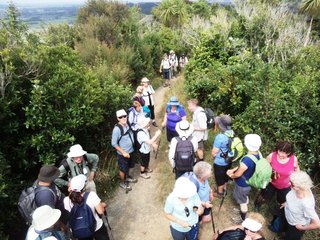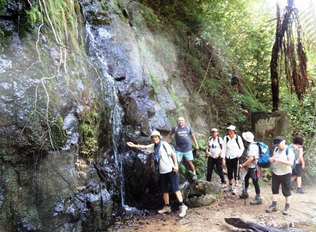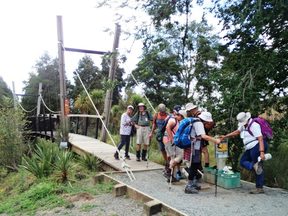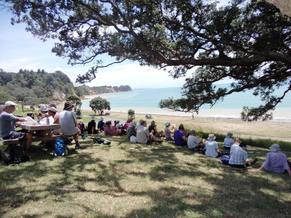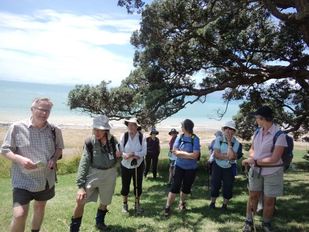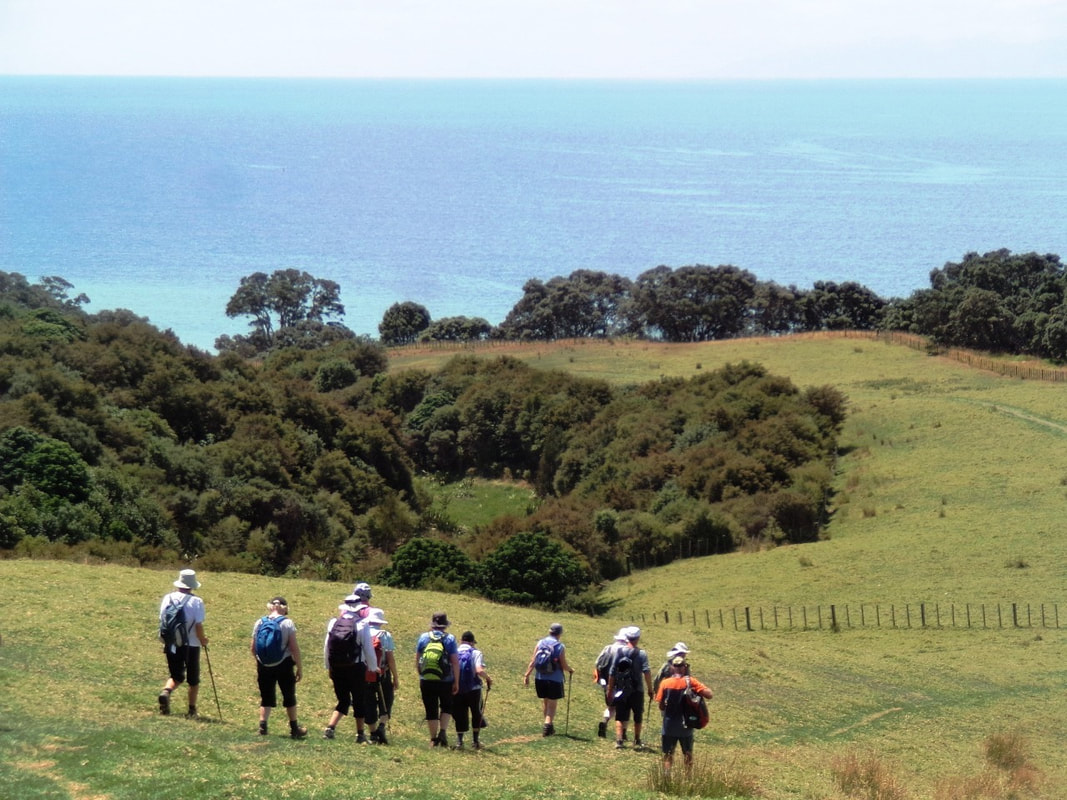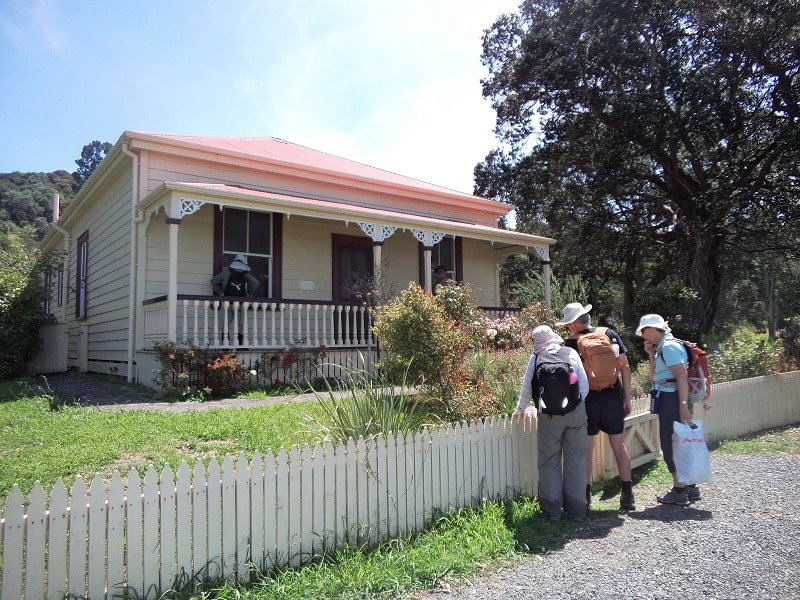Trip Reports : January - February 2018
18 February 2018
Onehunga to Mt. Eden
Our walk started in Onehunga Bay, where we walked along the only completed part of the proposed walkway from Onehunga, going westwards along the shore of Manukau Harbour. Returning the same way, we went on to cross the mouth of the harbour on the old bridge that had been built well over 100 years ago, to connect the villages of Onehunga and Mangere. No wonder it couldn’t cope with modern day traffic!
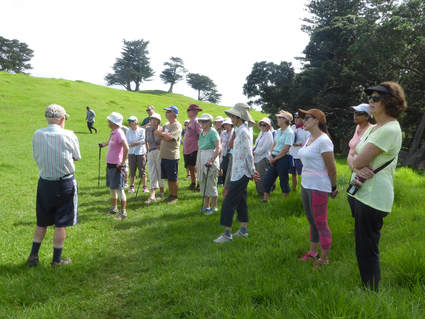 Des giving us a brief history of Mangere Mountain.
Des giving us a brief history of Mangere Mountain.
A short stop for morning tea, then we were off to Mangere Mountain. Before starting the climb, however, Des gave us a short history of the mountain. By the 17th century, warfare was rampant due to the growth of the population and feuds between various tribes but was also prolonged because there was no warrior class among Maori (to finish off a battle) and due to pauses in fighting to accommodate planting kumara in October and harvesting it in March, as well as the absence of weapons of mass destruction! We also saw an enormous kumara pit and terraced areas where dwellings would have been situated.
|
This landscape was the result of a very violent volcanic eruption, which resulted in an enormous lava flow spilling down and flowing as far as Meola Creek at Westmere. While most of the lava had erupted in a big rush, some of it had slowly bubbled up too, so that the cooling effect of the surrounding air allowed it to settle in the same spot and form a mound, quite a rare sight. |
From here we took the bus to the Pah Homestead, where we persuaded our driver Lyndon to walk a short way with us to see some extraordinary trees. Some then returned to the main building to admire the artwork, both indoors and outside.
Others carried on down the former coach track to look at more trees, both native and exotic. An Australasian fig stood next to the largest Moreton Bay Fig in Auckland, a Turkey Oak stood beside a Holm Oak (with fungi under it) and a Bunya Pine and not far from another Holm Oak was a Queensland Kauri with its wider, pointed leaves.
The track went through mature Puriri and Karaka, many more Moreton Bay Figs and mature Oaks as well as newly planted Totara and wound down towards what must have been a small wetland area at the far end.
The track went through mature Puriri and Karaka, many more Moreton Bay Figs and mature Oaks as well as newly planted Totara and wound down towards what must have been a small wetland area at the far end.
Next stop was what you could call The Last of the Three Kings: the largest of this group of three volcanic cones had been quarried in the 1920s and now another one of them seems to be vanishing in the cause of building more housing for Auckland’s ever increasing population. Some climbed up to the top of the remaining “King” for the view, others gave in to the heat and remained below, watching a baseball game in progress.
The quarrying of the first "King" must have been very rapid indeed: a nearby explanatory board described how a local person suddenly noticed one morning that they cold see Mt. Albert from their front yard where they had not had a view of it before!
The quarrying of the first "King" must have been very rapid indeed: a nearby explanatory board described how a local person suddenly noticed one morning that they cold see Mt. Albert from their front yard where they had not had a view of it before!
Finally, we went on to what may be Auckland’s most popular volcanic cone, Mt Eden, where Lyndon bravely drove his bus as far as motorised vehicles were allowed to go. We then walked up to the top, again having all-round views, went around the crater and then rewarded ourselves with enormous ice-creams.
A good day, we appreciated having only a short bus ride to the start of our first walk and having the bus taking us in between walks on a very warm and still day!
A good day, we appreciated having only a short bus ride to the start of our first walk and having the bus taking us in between walks on a very warm and still day!
Thanks to Janet and Elane, our leaders, and to Des for sharing his vast knowledge with us.
Photos and text: Praemi
Photos and text: Praemi
04 February 2018
Tiritiri Matangi Island
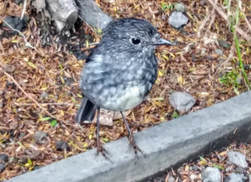 An ever-friendly North Island robin
An ever-friendly North Island robin
Tiritiri Matangi in the Hauraki Gulf has to be one of our favourite places to spend time. Just 75 minutes by ferry from Auckland, visitors step ashore onto land with an amazing history that is a safe haven for many of our rare and endangered birds.
Having taken great care to have our gear scrupulously clean, free of seeds and dirt, with no uninvited creepies or crawlies stowed away and with our food in sealed containers, we were happy that we would not be bringing any problems to this lovely place.
Tiri is a huge success story and has been described as "conservation in action". By the 1970s over a century of farming had resulted in the destruction of almost all of the native forest and the loss of wildlife on the island. A ten year Habitat Restoration Programme has eradicted pest predators and seen the planting of 250,000 native trees. From 1984 - 1994 thousands of volunteer groups and individuals formed "spade brigades" to restore Tiri's forest with trees grown in the island nursery. First pohutukawa, then puriri, kohekohe and taraire. Translocation of endangered birds from other sanctuaries in New Zealand followed and now 30 years on the island is full of birdsong once more.
Having taken great care to have our gear scrupulously clean, free of seeds and dirt, with no uninvited creepies or crawlies stowed away and with our food in sealed containers, we were happy that we would not be bringing any problems to this lovely place.
Tiri is a huge success story and has been described as "conservation in action". By the 1970s over a century of farming had resulted in the destruction of almost all of the native forest and the loss of wildlife on the island. A ten year Habitat Restoration Programme has eradicted pest predators and seen the planting of 250,000 native trees. From 1984 - 1994 thousands of volunteer groups and individuals formed "spade brigades" to restore Tiri's forest with trees grown in the island nursery. First pohutukawa, then puriri, kohekohe and taraire. Translocation of endangered birds from other sanctuaries in New Zealand followed and now 30 years on the island is full of birdsong once more.
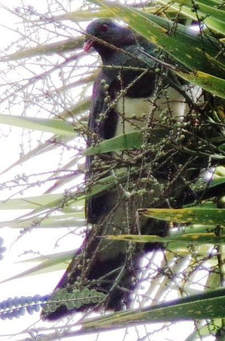 Happy and healthy kereru with his eye on us!
Happy and healthy kereru with his eye on us!
On our visit the delightful stitchbirds (hihi) and bellbirds were easy to see amongst the trees but also congregating around the feeding stations. They were very vocal and we would love to know what they were saying! Also spotted easily were very fat and healthy kereru, scores of tui, noisy saddlebacks, cheeky little robins and whiteheads.
We soon discovered that the best way to see birds was to stop and all keep still and quiet for a bit, then the birds would appear. Sadly the kokako didn't show themselves, nor did we hear their stunningly haunting song.
Likewise, the takahe weren't feeling sociable and disappeared. They had only been released from being penned up for health checks and vaccinations the day before so were off exploring we guessed. Some of us remembered Greg the Takahe who was famous in his time for greeting visitors off the boat and then ransacking their bags looking for their lunch. Greg was twenty years old when he died and is buried beneath a puriri tree near the bunkhouse, his grave beautifully marked.
On our visit the delightful stitchbirds (hihi) and bellbirds were easy to see amongst the trees but also congregating around the feeding stations. They were very vocal and we would love to know what they were saying! Also spotted easily were very fat and healthy kereru, scores of tui, noisy saddlebacks, cheeky little robins and whiteheads.
We soon discovered that the best way to see birds was to stop and all keep still and quiet for a bit, then the birds would appear. Sadly the kokako didn't show themselves, nor did we hear their stunningly haunting song.
Likewise, the takahe weren't feeling sociable and disappeared. They had only been released from being penned up for health checks and vaccinations the day before so were off exploring we guessed. Some of us remembered Greg the Takahe who was famous in his time for greeting visitors off the boat and then ransacking their bags looking for their lunch. Greg was twenty years old when he died and is buried beneath a puriri tree near the bunkhouse, his grave beautifully marked.
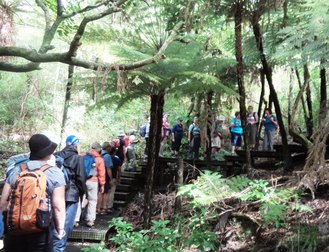 Kawerau Track
Kawerau Track
We were so lucky to have three of Tiri's volunteer guides accompany us on part of our walk. So good to have experts to identify bird calls, plants and tell us a bit of the history of Tiri.
Our whole group took a route from the ferry along Hobbs Beach, pausing to look into the little penguin boxes beside the track, then up to the Ridge Track via the Kawerau Track which is one of the best bird watching parts of the island. It was easy walking thanks to the excellent boardwalks, steps and informative display boards. Here we also saw an ancient pohutukawa, 800 - 1000 years old.
Much thought has gone into providing excellent signage on all the tracks, even small linking tracks, many of the trees are named and bird species identification boards are really helpful.
The fitter and faster amongst us separated off and travelled up to the Visitor Centre and lighthouse area via a different route - via Fisherman's Track and the East Coast Track where the views are magnificent. The remainder of us meandered onwards on the Cable Track. From the top we enjoyed 360 degree views of all the other islands in the Gulf and our helpful guide identified them all for us!
The fitter and faster amongst us separated off and travelled up to the Visitor Centre and lighthouse area via a different route - via Fisherman's Track and the East Coast Track where the views are magnificent. The remainder of us meandered onwards on the Cable Track. From the top we enjoyed 360 degree views of all the other islands in the Gulf and our helpful guide identified them all for us!
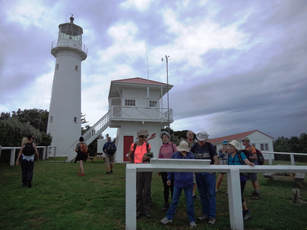 Lighthouse and signal station
Lighthouse and signal station
Tiri lighthouse has towered over the island since 1864 and is now the oldest working lighthouse in New Zealand. Now fully automated and solar powered, it is a story in itself. Ray Walter was the last lighthousekeeper and spent 26 years on the island, staying on to work for DOC and manage the replanting programme once the lighthouse was no longer manned.
The signal station was open for visitors, the shop was full of tempting things and we were generously given tea and coffee by the Friends of Tiri, before it was time to set off back to the ferry via the beautiful Wattle Track.
Many thanks to our Tiri guides, Rose, Geoff and Mike. Thanks also to Molly and Sharleen for organising the day.
To read more about Tiritiri Matangi see
http://www.tiritirimatangi.org.nz/
www.doc.govt.nz/parks-and-recreation/places-to-go/auckland/places/tiritiri-matangi-scientific-reserve-open-sanctuary/
Photos: Sue, Derek, Cheryl, Sharleen
Text: Sharleen
21 January 2018
Clevedon Reserve and Tapapakanga Regional Park
The promise of warm, dry weather lured 37 walkers out of bed reasonably early this Sunday morning, heading for Clevedon. We were there in hardly any time, with little traffic on the roads, to make a short comfort stop near the Clevedon craft market, then carry on to the nearby reserve. There was much to talk about on the way as we were catching up with each other after a long Christmas break, so the journey seemed even shorter than usual.
Walking up to the bridge that led to the reserve, we admired the large kahikatea trees in the area, then paused at the bridge to scrub and spray our already clean boots before entering this reserve, which we knew had some large kauri trees within it. Beyond the bridge, the two groups ('A' being faster walkers, 'B' being slower ones) split up and the A group started going up the loop track to the lookout with Don and Derek in an anti-clockwise direction. Soon after they departed, the other group followed John in a clockwise direction, with Wendy as the back-marker, hoping that both groups would reach the top simultaneously, to have morning tea together.
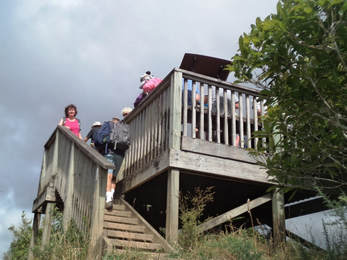 The viewing platform.
The viewing platform.
Alas for the best -laid plans of mice and men! We had several walkers who were keen on natural history in the 'B' group and the steps going up that way were also steep. Result: we stopped to show our newer members and visitors some of the native trees along the way. As there were many, many species in this reserve and, as they wanted to take photographs and ask questions, we did take rather longer to get to the top than anticipated, after climbing almost 800 steps!
We saw some kauri and kahikatea close to the start of the climb, then taraire and tawa, unusually in the same reserve, together with puriri, lancewood, rewarewa and kohekohe. We also spotted the usual suspects such as nikau, tree ferns, hange-hange and karaka.
We reminded ourselves that we are keen on natural history and not simply interested in tramping! Close to the top we met the other group, now coming down the way we had ascended.
We reminded ourselves that we are keen on natural history and not simply interested in tramping! Close to the top we met the other group, now coming down the way we had ascended.
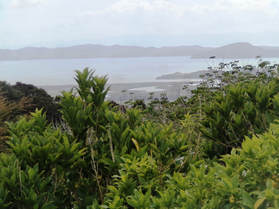 A good view over the eastern part of the Hauraki Gulf.
A good view over the eastern part of the Hauraki Gulf.
Once we reached the top, we agreed that the long climb was really worth it: there were all-round views, from the City of Sails and beyond it to North Shore, through 360 degrees, to as far as the eye could see. After a short stop for morning tea and a look around, we headed down in the opposite direction to our climb.
Anyone with sore knees will be thankful that the steps on the other side are not as steep as those we used to go up.
At the bottom, we re-crossed the bridge and scrubbed and sprayed our boots once more, then set off on the bus to our next walk.
Tapapakanga was a very different proposition: we began by having lunch in the only bit of shade we could find, then set off along the beach for a short distance before climbing a little way to reach farmland.
There we walked in unrelenting heat - the temperature must have been in the 30s - then along a fenceline, to reach an area with plaques that named the original settlers of this farmland, the Ashby family.
A few who were now giving in to the heat decided to stay in the shade afforded by the adjoining pohutukawas and enormous karakas, while the remainder went on for a further short distance. Finally we all descended to the beach using a short track, then along the beach for a good cooling walk with the breeze in our faces. Our last stop was the original homestead where we admired the design of the verandah and speculated on the amount of love and dedication it takes to look after these historic buildings.
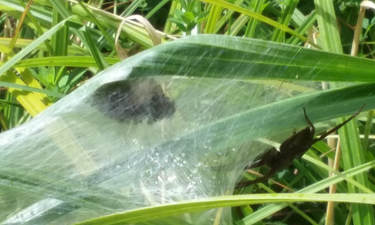 Nursery web spider and its web.
Nursery web spider and its web.
Gail took this superb photograph on the recce but the spider was not in evidence on the day of the walk!
Thanks to our leaders Derek, Don and John and to Wendy our "tail-ender" for Group'B' who did a sterling job.
Text: Praemi; Photos: Sue and Gail.
Text: Praemi; Photos: Sue and Gail.
